External links
- "Kanbalu, Burma"
- "Kanbalu Map — Satellite Images of Kanbalu" Maplandia.com
23°12′14″N95°30′55″E / 23.20389°N 95.51528°E / 23.20389; 95.51528
| | This Sagaing Region location article is a stub. You can help Wikipedia by expanding it. |
Kanbalu (also spelt Kantbalu [1] ) is a town in Shwebo District, Sagaing Division, in Myanmar. It is the administrative seat for Kanbalu Township. Kanbalu is on the main Burmese north-south railroad between Sagaing and Myitkyina. [1] As of 2014, it had a population of 25,022 [2]
Its railyards were bombed by the Allies during World War II. [3] During the Myanmar Civil War, it was attacked by resistance forces, who torched the local police station. [4]
The military-run Myanmar Economic Corporation operates two factories, manufacturing sugar and menthol, in Kantbalu. [5] The sugar factory is a joint venture with Thai-owned Sutech Engineering. [6] Kanbalu is also home to the 30 megawatts (40,000 hp) Thaphanseik hydropower plant on the Mu River, a $20-million project financed by the China Import and Export Bank. [7]
23°12′14″N95°30′55″E / 23.20389°N 95.51528°E
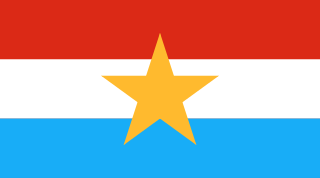
The Tatmadaw is the military of Myanmar. It is administered by the Ministry of Defence and composed of the Myanmar Army, the Myanmar Navy and the Myanmar Air Force. Auxiliary services include the Myanmar Police Force, the Border Guard Forces, the Myanmar Coast Guard, and the People's Militia Units. Since independence in 1948, the Tatmadaw has faced significant ethnic insurgencies, especially in Chin, Kachin, Kayin, Kayah, and Shan states. General Ne Win took control of the country in a 1962 coup d'état, attempting to build an autarkic society called the Burmese Way to Socialism. Following the violent repression of nationwide protests in 1988, the military agreed to free elections in 1990, but ignored the resulting victory of the National League for Democracy and imprisoned its leader Aung San Suu Kyi. The 1990s also saw the escalation of the conflict involving Buddhists and Rohingya Muslims in Rakhine State due to RSO attacks on the Tatmadaw forces, which saw the Rohingya minority facing oppression and, starting in 2017, genocide, under the rule of democratically elected president Aung San Suu Kyi.

Sagaing Region is an administrative region of Myanmar, located in the north-western part of the country between latitude 21° 30' north and longitude 94° 97' east. It is bordered by India's Nagaland, Manipur, and Arunachal Pradesh States to the north, Kachin State, Shan State, and Mandalay Region to the east, Mandalay Region and Magway Region to the south, with the Ayeyarwady River forming a greater part of its eastern and also southern boundary, and Chin State and India to the west. The region has an area of 93,527 square kilometres (36,111 sq mi). In 1996, it had a population of over 5,300,000 while its population in 2012 was 6,600,000. The urban population in 2012 was 1,230,000 and the rural population was 5,360,000. The Capital city and the largest city of Sagaing Region is Monywa.
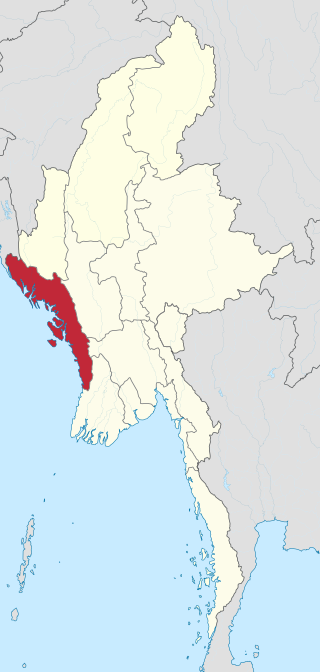
Rakhine State, formerly known as Arakan State, is a state in Myanmar (Burma). Situated on the western coast, it is bordered by Chin State to the north, Magway Region, Bago Region and Ayeyarwady Region to the east, the Bay of Bengal to the west and the Chittagong Division of Bangladesh to the northwest. It is located approximately between latitudes 17°30' north and 21°30' north and longitudes 92°10' east and 94°50' east. The Arakan Mountains or Rakhine Yoma separated Rakhine State from central Burma from North to South. Off the coast of Rakhine State there are some fairly large islands such as Ramree, Cheduba and Myingun. Rakhine State has an area of 36,762 square kilometres (14,194 sq mi) and its capital is Sittwe.
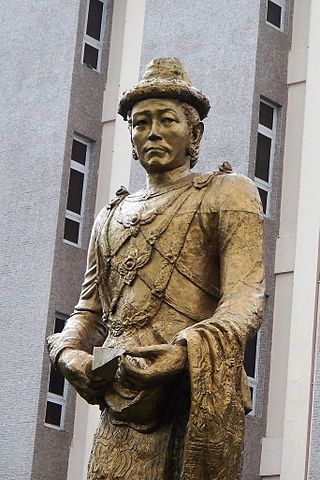
Alaungpaya was the founder and first emperor of the Konbaung Dynasty of Burma (Myanmar). By the time of his death from illness during his campaign in Siam, this former chief of a small village in Upper Burma had unified Burma, subdued Manipur, conquered Lan Na and defeated the French and the British who had given help to the Restored Hanthawaddy Kingdom. He added settlements around Dagon, and called the enlarged town Yangon.

The Irrawaddy River is a river that flows from north to south through Myanmar (Burma). It is the country's largest river and most important commercial waterway. Originating from the confluence of the N'mai and Mali rivers, it flows relatively straight north–south before emptying through the Irrawaddy Delta in the Ayeyarwady Region into the Andaman Sea. Its drainage basin of about 404,200 square kilometres (156,100 sq mi) covers a large part of Burma. After Rudyard Kipling's poem, it is sometimes referred to as 'The Road to Mandalay'.
Upper Myanmar is one of two geographic regions in Myanmar, the other being Lower Myanmar. Located in the country's centre and north stretches, Upper Myanmar encompasses 6 inland states and regions, including Mandalay, Sagaing, Magway Regions, and Chin, Kachin and Shan States. By contrast, Lower Myanmar encompasses the southern and coastal-facing regions of Myanmar. Upper Myanmar is home to several distinct cultural regions, including the homeland of the Bamar in the low-lying central plains, and those of the Chin, Kachin, and Shan peoples in the highlands. Home to over 23 million people, the region's agricultural sector, natural resources, and shared borders with India, China, and Thailand have made Upper Myanmar a major economic hub. Four of Myanmar's ten largest cities, Mandalay, Taunggyi, Monywa, and Myitkyina, are located in the region.

Homalin or Hommalinn is a small town in north-western Burma and capital of the Homalin Township in Hkamti District of the Sagaing Region. The town lies on the Chindwin River and is served by Homalin Airport.
Kawlin (ကောလင်းမြို့) is a town in the Sagaing Division in Myanmar. Since December 2018 it has been the administration headquarters for Kawlin District as well as Kawlin Township. As of 2019, the town had a population of 25,254, up from 21,431 in 2014. The town is further subdivided into 8 wards.
U Kyaw Myint also known as May Flower Kyaw Win is a noted Burmese businessman and political figure. He is one of the wealthiest tycoons in Burma and is one of the country's leading industrialists and bankers. He is the director-general of the Directorate of Industry under the Ministry of Industry of Burma.
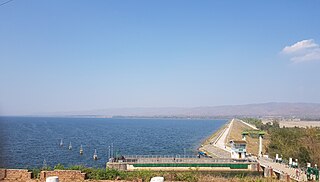
There are almost 200 large dams in Myanmar. Myanmar (Burma) has a large hydroelectric power potential of 39,000 megawatts (52,000,000 hp), although the economical exploitable potential is about 37,000 megawatts (50,000,000 hp). Between 1990 and 2002, the country tripled its installed capacity of hydro plants, increasing from 253 megawatts (339,000 hp) to 745 megawatts (999,000 hp). Total installed capacity in 2010 is at least 2,449 megawatts (3,284,000 hp) MW, 6% of potential. Several large dams are planned to increase future hydro utilization.

The Konbaung–Hanthawaddy War was the war fought between the Konbaung Dynasty and the Restored Hanthawaddy Kingdom of Burma (Myanmar) from 1752 to 1757. The war was the last of several wars between the Burmese-speaking north and the Mon-speaking south that ended the Mon people's centuries-long dominance of the south.
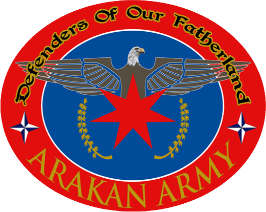
The Arakan Army is an ethnic armed organisation based in Rakhine State (Arakan). Founded on 10 April 2009, the AA is the military wing of the United League of Arakan (ULA). It is currently led by commander in chief Major General Twan Mrat Naing and vice deputy commander Brigadier General Nyo Twan Awng. The Arakan Army states that the objective of its armed revolution is to restore the sovereignty of the Arakan people. In a February 2024 interview, Twan Mrat Naing claimed that the AA had grown to at least 38,000 troops. Anthony Davis, an expert of military and security, rejected this claim and estimated that it has at least 15,000 troops in Chin State and Rakhine State, in adition to around 1500 in Kachin and Shan State. In the early 2010s, the Arakan Army fought alongside the Kachin Independence Army (KIA) against the Tatmadaw in the Kachin conflict. Following the 2016 outbreak of conflict in Rakhine state, AA became more heavily involved in the Arakan region. In 2019, AA would launch attacks on state security forces and the Myanmar Army would respond heightening clashes. The AA reached a ceasefire in late 2020 after eroding the central government's control in northern Rakhine. The power vacuum would be filled by the AA over the next 18 months with state-building efforts, like their COVID-19 vaccine rollouts.

The People's Defence Force is the armed wing of the National Unity Government (NUG) in Myanmar. The armed wing was formed by the NUG from youths and pro-democracy activists on 5 May 2021 in response to the coup d'état that occurred on 1 February 2021 that put the military junta and their armed wing the Tatmadaw in power. The military junta designated it as a terrorist organisation on 8 May 2021. In October 2021, NUG's Ministry of Defence announced that it had formed a central committee to coordinate military operations across the country.

The Myanmar civil war, also called the Myanmar Spring Revolution or People's Defensive War, is an ongoing civil war following Myanmar's long-running insurgencies, which escalated significantly in response to the 2021 military coup d'état and the subsequent violent crackdown on anti-coup protests. As of January 2024, recent losses have meant the surrender of thousands of soldiers, including six generals and thousands who have surrendered without a fight. However, others warn that coup forces remain "formidable and well-equipped", with "external allies and economic resources".
Events in the year 2022 in Myanmar.
The following is a timeline of major events during the Myanmar civil war (2021–present), following the 2021 military coup d'état and protests. It was also a renewed intensity in existing internal conflict in Myanmar.
This is the list of important events happened in Myanmar in 2023.
The Tar Taing massacre was a mass killing of civilians by Burmese military forces between 1 and 2 March 2023, in the village of Tadaing, Sagaing Region, located 28 miles (45 km) west of Mandalay, Myanmar's 2nd largest city. During the massacre, Myanmar Army troops killed at least 17 civilians. The event has become one of Myanmar's deadliest civilian massacres in 2023. Just nine days after this massacre, military troops killed at least 28 additional individuals in the Pinlaung massacre.
On 11 April 2023, the Myanmar Air Force massacred at least 165 people in the village of Pazigyi, Kantbalu Township, which is located 92 miles (148 km) west of Mandalay, Myanmar's second largest city. The Air Force used fighter jets and helicopters to attack a large crowd of people gathering for the opening of a local office of an opposition movement. The Pazigyi attack was the junta's deadliest attack since seizing power in the 2021 coup d'état.
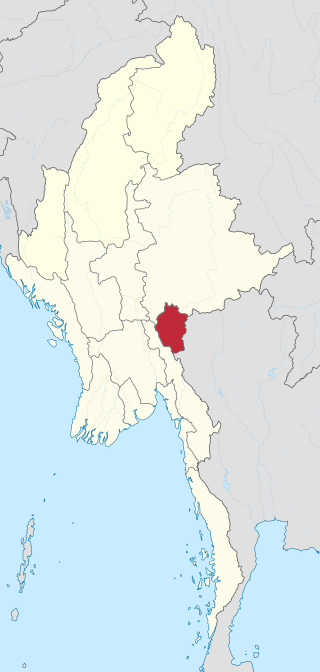
Operation 1111 is an ongoing military operation launched by Karenni Ethnic Armed Organisations (EAOs) including the Karenni Army (KA), Karenni Nationalities Defence Force (KNDF) and Karenni National People's Liberation Front (KNPLF). The operation was launched concurrently with Operation 1107, with the goal to capture Kayah State's capital city of Loikaw.